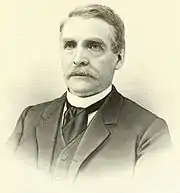John Martin (businessman)
John Martin (August 18, 1820–May, 1905) of Peacham, Vermont was an American steamboat captain and businessman in Minneapolis, Minnesota involved in lumber and flour milling.[1] In 1891, Martin led a merger of six mills to create Northwestern Consolidated Milling Company, at the time the world's second largest flour milling company after Pillsbury-Washburn.
John Martin | |
|---|---|
 | |
| Born | August 18, 1820 Peacham, Vermont, United States |
| Died | May 5, 1905 (aged 84) Minneapolis, Minnesota, United States |
| Occupation | Steamboat captain, businessperson, lumberman, miller philanthropist |
| Spouse(s) | Jane Gillfillan |
| Children | Jean Martin Brown |
In 1855 he was standard-bearer and leader on horseback of the ceremonial opening of the Hennepin Avenue Bridge the first major, permanent bridge across the Mississippi River[2]
He was also President of the First National Bank, owner of the largest lumber mill in the area until it burned in 1887 (by then recently under new owners)[3] and founding officer of Minneapolis and St. Louis Railway and Minneapolis, St. Paul and Sault Ste. Marie Railroad[4][5]
Later in life he provided primary funding and major impetus (along with his daughter Jean) for the founding of the Children's Home Society of Minnesota, then called the Jean Martin Brown Receiving Home.
Martin was married to Miss Jane B. Gilfillan[6] sister of Representative John Bachop Gilfillan of Minnesota.
They had one child, Jean (Martin) Brown. Jean Martin's son (John Martin's grandson) was Earle Brown,[7] noted Hennepin County Sheriff (1920), founder of the Minnesota State Patrol (1929), and Republican gubernatorial candidate for Minnesota (1932). He was also noted, like his grandfather, for his equestrian interests and special interest in Belgian Horse showing and breeding.
John Martin is buried in the Martin-Gilfillan family plot with his wife Jane, daughter Jean, and grandson Earle at Lakewood Cemetery in Minneapolis.
His funeral was held at 925 6th Street SE, Minneapolis[8] (still standing), the home was designed by noted architect Earnest Kennedy and was built with the intention of sharing it with his nephew Earl Browne. After John Martin died, Earle Brown lived there until 1909, when the property was sold to noted geologist Horace V. Winchell and Brown moved permanently to Brooklyn Farm in Brooklyn Center, Minnesota.
Notes
- Atwater, Isaac (1893). History of the City of Minneapolis, Minnesota via Internet Archive. Munsell. p. 628. Retrieved 2007-04-21.
- Atwater, Isaac (1893). History of Minneapolis v.1. p. 350.
- Hudson, Horace (1908). A Half Century of Minneapolis. Hudson Publishing Company. p. 320.
john martin lumber minneapolis fire.
- Hudson, Horace. A Half Century of Minneapolis. p. 310.
- Atwater, Isaac (1893). History of the City Of Minneapolis v.2. Munsell. pp. 629–631.
captain john martin minneapolis.
- "Captain Martin is Dead". Minneapolis Journal. 1905-05-26. p. 5. Retrieved 7 May 2013.
- "History of Earl Brown Center". Archived from the original on 17 May 2013. Retrieved 7 May 2013.
- "Captain Martin Buried". Minneapolis Journal. 1905-05-29. Retrieved 7 May 2013.